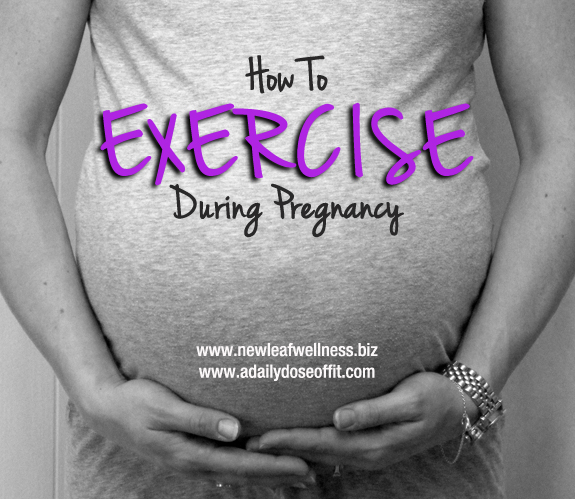Exercise is important, this we know. But during pregnancy…can you still hit the gym? Can you run? Is it safe? Yes, yes and yes. However, there are certain things you’ll need to consider to get the most out of your prenatal fitness excursions because, as you know, this is a very delicate and precious time for your body. Not only is it YOUR life source, it’s actually growing another human being—a feat not to be taken lightly, and all the more reason to keep moving. Because, as I’m sure you’ve heard before, exercise is part of that which fuels us.
As a certified personal trainer and mom to one, I can say with certainty that the following will help you exercise safely during pregnancy.
How to Exercise Safely During Pregnancy
1. Talk to your doctor or midwife.
Tell them about your pre-pregnancy fitness routines and ask them if you need to be restricted in any way. And if they restrict you, take these restrictions seriously. If for some reason you question their restrictions, ask for explanations. For example, my doctor told me up front that running during pregnancy wasn’t a great idea. But once I explained to her that I had been running regularly for years, it shed some light on my body’s abilities and she helped me understand how to approach running while pregnant.
2. Re-evaluate your fitness goals.
Prenatal fitness prepares you for labor…not for personal records. Prenatal fitness is not about weight loss, but it can minimize excessive weight gain during pregnancy. You’ll need to accept the fact that your body will get tired quicker than usual. And as you progress in months, you might notice your strength dropping a bit. Again, this is normal. And helpful…exercise can lead to post-workout energy gains, even if you aren’t pregnant! So follow the “do what you can” approach to fitness during pregnancy.
3. Be mindful of your growing bump.
It will throw off your center of gravity, which can lead to balance and back issues. Try to walk and/or run as normally as possible, avoiding any unnecessary arching of the lower back to compensate for a belly that wants to pull you forward. Use a belly band, if necessary. Many women find great comfort in these products before, during and after their workouts.
4. Eat a light snack before your workout.
Your body is working overtime to bake that baby, and it needs all the fuel it can get. Especially when you ask it to exercise, too. Rule of thumb: A healthy carb does wonders for your energy and your blood sugar. Something like a bagel with peanut butter, or even a banana. And drink plenty, plenty of water.
5. Be mindful of your newfound flexibility.
All those hormones surging through your body can soften you in places otherwise thought to be tight. So keep all of your motions controlled during your prenatal workouts so as not to hurt anything. Be careful with lateral (side to side) movements, specifically, because your hips are really starting to change. The last thing you need is an injury on top of your pregnancy. The human body can only deal with so much at once, right?
Right. So let’s get a little more specific.
1. Any core exercise that compresses or twists the abdomen.
2. Exercises lying down on your back.
Specifically after the first trimester, for obvious reasons.
3. Weights that cause an overly strenuous reaction.
If you need to hold your breath, break form or otherwise challenge your body in a contraindicated way, you’re probably lifting too much.
4. High intensity workouts.
Excessively high heart rates should often be avoided during pregnancy, but again, you’ll need to speak with your doctor for specific instructions.
5. Inversions.
Inversions can throw a typical woman into a lightheaded state of affairs. A pregnant woman’s circulatory system is already in overdrive, putting her at a greater risk of fainting during or coming out of an inversion (like a down-dog, for example).
1. Core isolation exercises, provided they keep you off your back.
Planks, for example, are excellent choices but you’ll have to modify as the belly grows.
2. Upper-body exercise, like rows.
As the, ahem…ladies grow, you’ll need all the support you can get from those back muscles to keep your chest upright. I recommend using a band with handles (wrapped around a pole), rather than a machine, because it will force you to balance yourself using your core muscles (which, as you know, can be hard to work during pregnancy).
3. Low-back exercises are essential.
Look for a low-back specific machine, but make sure it doesn’t require you to bend over a pad…obviously a no-no because the belly will get compressed. If you can’t find a machine, remember that planks and dead lifts also work the lower back (although you’ll want to be careful not to bend below the heart during your dead lift, see #5 above regarding inversions).
4. Squats.
Always a great choice as they work almost every aspect of your lower body, especially if you’re interested in the squat method of pushing.
5. Prenatal yoga.
I took it during my last trimester and I can’t rave enough about it. It really was wonderful, not only for the strength and flexibility aspect, but for the breathing aspect, too. Breathing is so essential during labor and deliver, and I often found myself thinking “yoga breathing, yoga breathing” during contractions.
Again, I cannot emphasize enough the importance of an open dialogue with your doctor or midwife. Ask questions! Take advantage of those monthly/weekly appointments!
And remember, walking regularly, if that’s all you can do, is absolutely better than nothing. So when those pregnancy hormones make you feel like crud, as easy as it is to stay on the couch, if you can muster up the energy, get out there for a nice walk…because why? Exercise can make you feel better. And if you’ve got a kicker, it might even lull them to sleep to give your insides a break.
Congrats, mommas. And keep in touch. There’s nothing I love to hear about more than a fit pregnancy!









Overall, this is a great post. However, I’d caution against doing planks while pregnant, especially into your late 2nd and 3rd trimesters. The uterus has 2 sets of ligaments. One set connects a the front of the pelvis, the other is at the sacrum. So, the weight of your uterus is now hanging from your SI which is already under stress from your growing belly. This can exacerbate low back pain. The other concern is the rectus abdominus. The growing uterus increases the intra-abdominal pressure on the RA and postures like plan can add to that pressure, greatly, thus increasing… Read more »
Thanks for sharing, Deena. Your points are all very valid. I did planks throughout my entire pregnancy and I know a number of women who’ve done them as well without any problem. Of course, it’s always important to remember that each pregnancy is different because each woman’s body is different. What works for one or what is appropriate for one might not be for another. If a woman is used to doing planks and can hold them for a considerable amount of time before pregnancy, then they may find success with them during pregnancy as well. Remember, they can always… Read more »
Great article, and I do agree with Deena. Planks can be great for someone with no extra pressure in their core, but they have been proven to contribute to diastasis recti (DR) during pregnancy. The downward pressure of a growing uterus/baby simply is too great against the linea alba in the 3rd trimester, and while you might get away with it for the first pregnancy, subjecting your linea alba to more and more stress with such moves when it’s starting to thin is a recipe for a much longer post-partum recovery. I didn’t find out about DR until after my… Read more »